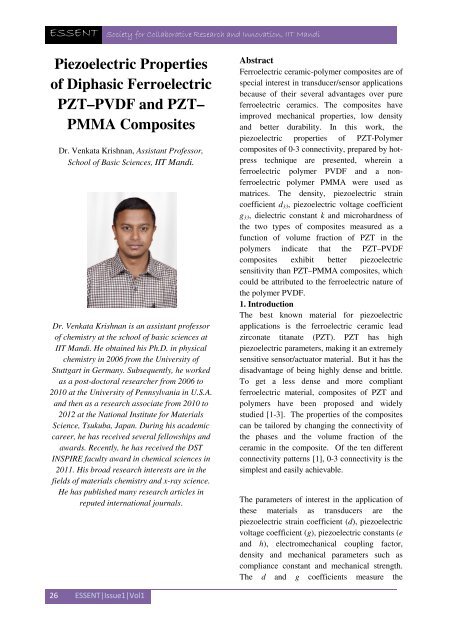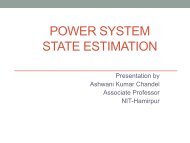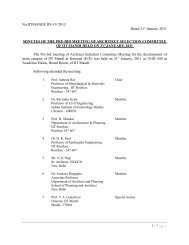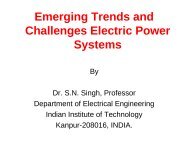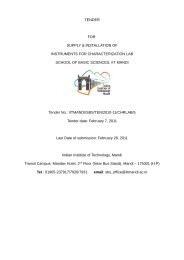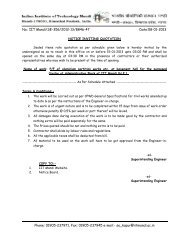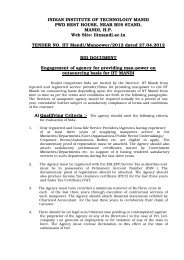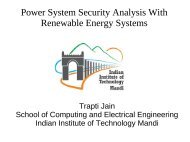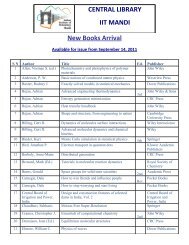Issue1. Vol.1 (April, 2013) - IIT Mandi
Issue1. Vol.1 (April, 2013) - IIT Mandi
Issue1. Vol.1 (April, 2013) - IIT Mandi
- No tags were found...
Create successful ePaper yourself
Turn your PDF publications into a flip-book with our unique Google optimized e-Paper software.
ESSENT Society for Collaborative Research and Innovation, <strong>IIT</strong> <strong>Mandi</strong>Piezoelectric Propertiesof Diphasic FerroelectricPZT–PVDF and PZT–PMMA CompositesDr. Venkata Krishnan, Assistant Professor,School of Basic Sciences, <strong>IIT</strong> <strong>Mandi</strong>.Dr. Venkata Krishnan is an assistant professorof chemistry at the school of basic sciences at<strong>IIT</strong> <strong>Mandi</strong>. He obtained his Ph.D. in physicalchemistry in 2006 from the University ofStuttgart in Germany. Subsequently, he workedas a post-doctoral researcher from 2006 to2010 at the University of Pennsylvania in U.S.A.and then as a research associate from 2010 to2012 at the National Institute for MaterialsScience, Tsukuba, Japan. During his academiccareer, he has received several fellowships andawards. Recently, he has received the DSTINSPIRE faculty award in chemical sciences in2011. His broad research interests are in thefields of materials chemistry and x-ray science.He has published many research articles inreputed international journals.AbstractFerroelectric ceramic-polymer composites are ofspecial interest in transducer/sensor applicationsbecause of their several advantages over pureferroelectric ceramics. The composites haveimproved mechanical properties, low densityand better durability. In this work, thepiezoelectric properties of PZT-Polymercomposites of 0-3 connectivity, prepared by hotpresstechnique are presented, wherein aferroelectric polymer PVDF and a nonferroelectricpolymer PMMA were used asmatrices. The density, piezoelectric straincoefficient d 33 , piezoelectric voltage coefficientg 33 , dielectric constant k and microhardness ofthe two types of composites measured as afunction of volume fraction of PZT in thepolymers indicate that the PZT–PVDFcomposites exhibit better piezoelectricsensitivity than PZT–PMMA composites, whichcould be attributed to the ferroelectric nature ofthe polymer PVDF.1. IntroductionThe best known material for piezoelectricapplications is the ferroelectric ceramic leadzirconate titanate (PZT). PZT has highpiezoelectric parameters, making it an extremelysensitive sensor/actuator material. But it has thedisadvantage of being highly dense and brittle.To get a less dense and more compliantferroelectric material, composites of PZT andpolymers have been proposed and widelystudied [1-3]. The properties of the compositescan be tailored by changing the connectivity ofthe phases and the volume fraction of theceramic in the composite. Of the ten differentconnectivity patterns [1], 0-3 connectivity is thesimplest and easily achievable.The parameters of interest in the application ofthese materials as transducers are thepiezoelectric strain coefficient (d), piezoelectricvoltage coefficient (g), piezoelectric constants (eand h), electromechanical coupling factor,density and mechanical parameters such ascompliance constant and mechanical strength.The d and g coefficients measure the26 ESSENT|Issue1|Vol1


